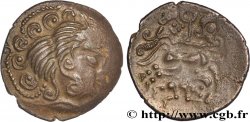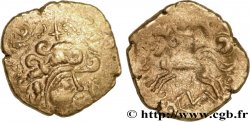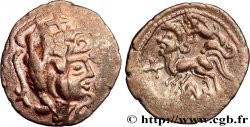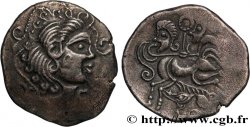bga_285892 - VENETI (Area of Vannes) Statère d'électrum au personnage recroquevillé ailé – aux esses
недоступный.
Товар уже продан в нашем интернет-магазине (2014)
Цена: : 1 850.00 €
Товар уже продан в нашем интернет-магазине (2014)
Цена: : 1 850.00 €
Тип Statère d'électrum au personnage recroquevillé ailé – aux esses
Дата: c. 80-50 AC.
Монетный двор / Город: Vannes (56)
Металл: electrum
Диаметр: 20,5 mm
Ориентация осей монеты: 7 h.
Вес: 6,89 g.
Редкость: R3
Комментарии о состоянии
Flan un peu court, avec des types presque complets malgré une frappe un peu décentrée des deux côtés. Patine claire au droit, un peu plus sombre au revers avec des concrétions dans les creux
Ссылки в каталоге: :
Происхождение:
Cet exemplaire est le n°50 du trésor d'Hennebont ; il est issu des coins D28 - R38.
Лицевая сторона
Аверс: легенда: ANÉPIGRAPHE.
Аверс: описание: Tête stylisée à droite, la chevelure composée de cinq mèches en esses et en rouleaux, avec une croix au-dessus ; un motif triangulaire devant le front, avec des cordons perlés autour de la tête, terminés par de petites têtes coupées ; le menton est terminé par une sorte d’esse et une autre esse figure devant la bouche.
Обратная сторона
Реверс: легенда: ANÉPIGRAPHE.
Реверс: Описание: Cheval androcéphale à gauche, conduit par un aurige tenant un fouet terminé par une croisette en guise de stimulus devant le poitrail ; une esse évidée entre le stimulus et le poitrail ; un petit personnage recroquevillé et ailé entre les jambes du cheval.
Комментарий
Représentée par les treize exemplaires n° 45 à 57, cette variante manque à la classification de P. Abollivier. D’un style de droit proche des monnaies précédentes, mais avec une tête plus petite, ces statères ont la particularité d’avoir une petite esse devant la bouche au droit et une autre esse dédoublée entre le stimulus et le poitrail du cheval au revers.
Un motif en fleuron, comparable à celui présent sur les statères des types de Carantec et du Catillon, est représenté dans la chevelure au droit (cf. n° 45, 47, 52-56) et au revers sous la queue du cheval (cf. n° 57). Le n° 56 a d’ailleurs un fleuron inversé dans la chevelure par rapports aux autres statères.
Ces treize statères sont issus de trois coin de droit (D28-30) et de quatre coins de revers (R37-40).
Represented by the thirteen examples nos. 45 to 57, this variant is missing from P. Abollivier's classification. In a style of right close to the previous coins, but with a smaller head, these staters have the particularity of having a small esse in front of the mouth on the right and another esse split between the stimulus and the chest of the horse on the reverse. A fleuron motif, comparable to that present on the staters of the Carantec and Catillon types, is represented in the hair on the right (cf. n° 45, 47, 52-56) and on the reverse under the horse's tail (cf. . No. 57). No. 56 also has an inverted fleuron in the hair compared to the other staters. These thirteen staters come from three right corners (D28-30) and four reverse dies (R37-40)
Un motif en fleuron, comparable à celui présent sur les statères des types de Carantec et du Catillon, est représenté dans la chevelure au droit (cf. n° 45, 47, 52-56) et au revers sous la queue du cheval (cf. n° 57). Le n° 56 a d’ailleurs un fleuron inversé dans la chevelure par rapports aux autres statères.
Ces treize statères sont issus de trois coin de droit (D28-30) et de quatre coins de revers (R37-40).
Represented by the thirteen examples nos. 45 to 57, this variant is missing from P. Abollivier's classification. In a style of right close to the previous coins, but with a smaller head, these staters have the particularity of having a small esse in front of the mouth on the right and another esse split between the stimulus and the chest of the horse on the reverse. A fleuron motif, comparable to that present on the staters of the Carantec and Catillon types, is represented in the hair on the right (cf. n° 45, 47, 52-56) and on the reverse under the horse's tail (cf. . No. 57). No. 56 also has an inverted fleuron in the hair compared to the other staters. These thirteen staters come from three right corners (D28-30) and four reverse dies (R37-40)








 Cообщить об ошибке
Cообщить об ошибке Распечатать страницу
Распечатать страницу Отправить мой выбор
Отправить мой выбор Задать вопрос
Задать вопрос Consign / sell
Consign / sell
 Информация
Информация












